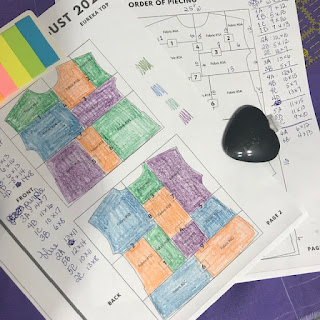After I read Patti's review of the Emerald Dress and Top, I needed it. It is still hot as Hades here and I do love a linen dress.
This shift dress is composed of 4 panels - two fronts and two backs. This is necessary to in order manage the bias cut. The direction of the bias is mirrored across the front and across the back. It provides a flattering vertical seam down the front and back.
First I made the top in a beefy linen that I thought of as hot pink. DH called it red and it does read red too. After all, what is deep pink if not red? Either way I find it to be a delicious color, and it makes me feel good to wear it. I bought it at my local wonderful Gail K on Cheshire Bridge Road in Atlanta.
It is still a little short at the sides, but not bad. And adding 3 inches might have made it too long in the front and back. The hem is dramatically curved, similar to a man's shirt.
I love, love, love the drape of bias cut linen. It makes me feel feminine, yet comfy.
Next I pulled out a nicely aged black something-or-other I purchased at my local ASG tag sale a while back. It is at least 60" wide and I think I started with about 4 yards, plenty for the dress. And something else too.
The burn test and the selvedge read rayon, but I think there is something else mixed with the rayon, maybe cotton. It is lightweight, not transparent though. The drape is just right for a bias cut garment, I think. Maybe I said that already. This pattern benefits from some pretty drape.
The dress and the top have deep facings for the armholes, the neckline and the lower hem. These are top-stitched in place adding a nice design detail and serving a good purpose. I especially appreciate the deep hem facing with the light weight black fabric, as it adds some needed weight to the bottom.
The dress includes in-seam pockets and a novel (to me) manner of insertion. It is actually easier than the way I usually insert in-seam pockets. The directions have you attach a single pocket to each front side seam and each back side seam separately.
Then you align them for stitching of the side seams. I'm not sure the result is as flat as my usual method. This one requires that you press the side seams to the front, something that feels a little off to me.
I am also not thrilled with the finishing on the lower point of the armholes. It finishes nicely on the right side, but not as cleanly on the inside.
The instructions were not as exacting there as I would have liked. On the top, I just winged it in the absence of specifics in the directions.
On the dress, I lined up the dots and only stitched between the dots, thinking that might provide a clean finish inside. Ultimately it made no difference. The inside is still a little unsatisfactory.
All of these points are picky, picky. It is a beautifully drafted pattern with clear directions. I think it would be instructive and helpful for even a beginner.
And I think the shape is just darned nice.
























































